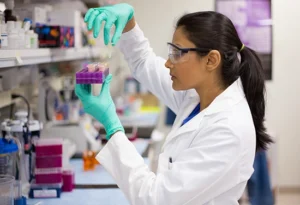March 5, 2020
Type 1 diabetes (T1D) is an autoimmune disorder that is often difficult to manage. Despite recent advances in innovative medical devices and educational tools, many people with T1D often experience blood sugar swings that can put them at risk of complications including hypoglycemia and hyperglycemia. Adding adjunct therapy to existing insulin treatment regimens could soon change that.
The artificial pancreas (also known as a closed-loop) is a promising technology consisting of a system of devices that closely mimics the glucose-regulating function of a healthy pancreas. It comprises a continuous glucose monitor (CGM), an insulin pump, and a computer algorithm that enables these devices to communicate and automate insulin delivery according to a person’s needs in real time. The artificial pancreas systems that are currently available automate basal insulin, and still require the user to give manual boluses via their insulin pump, but research working to develop a fully automated system. One approach towards a fully automated system is incorporating additional hormones or drugs.
.jpg) |
 |
 |
|
Drs. Ahmad Haidar, Laurent Legault, Michael Tsoukas and Jean-Franҫois Yale are a team of JDRF-funded researchers at McGill University (Montreal) who are the first to test the addition of pramlintide (a synthetic form of amylin, which is a hormone co-secreted with insulin by the healthy pancreas) to an artificial pancreas system – a combined treatment they hypothesize would help patients achieve optimal glucose control during the day. Previous studies have shown that pramlintide prevents blood sugar spikes following a meal through affecting digestion and the release of other hormones. Pramlintide – which is already approved and available in the USA – can be taken by injection, but is rarely used. In this study, the researchers set out to test the effects of pramlintide when delivered together with insulin in an artificial pancreas system.
Blood sugar levels in people wearing an artificial pancreas (AP) with insulin alone vs an AP with insulin + pramlintide.
Starting blood sugars were 5-10 mmol/L. Adapted from Haidar et al, Diabetes Care 2020; 43: 597-606.

To test their hypothesis, the researchers conducted a clinical trial in adults with T1D who wore artificial pancreas systems with or without pramlintide during inpatient visits at the Research Institute of McGill University Health Centre. The results of the trial showed that adding pramlintide to rapid-acting insulin in an artificial pancreas system improved glucose control compared to rapid-acting insulin alone, without increasing hypoglycemia. In the next stage of their research, Dr. Haidar and his team are conducting another clinical trial to test whether the insulin-plus-pramlintide artificial pancreas system can eliminate the need for carb-counting in adolescents and adults with T1D.
This exciting research into insulin adjunct therapy brings us closer to less burdensome management of T1D and a better quality of life.




